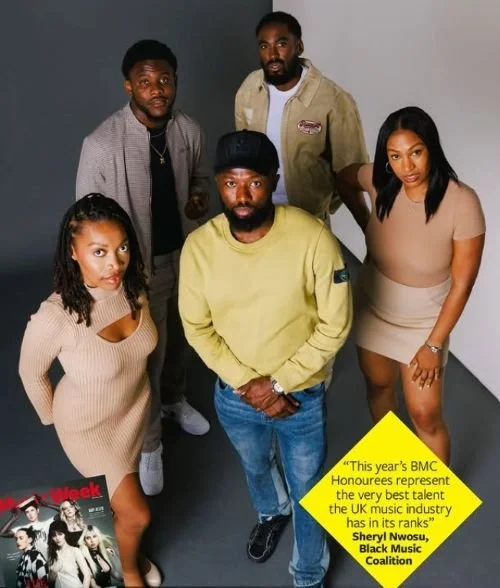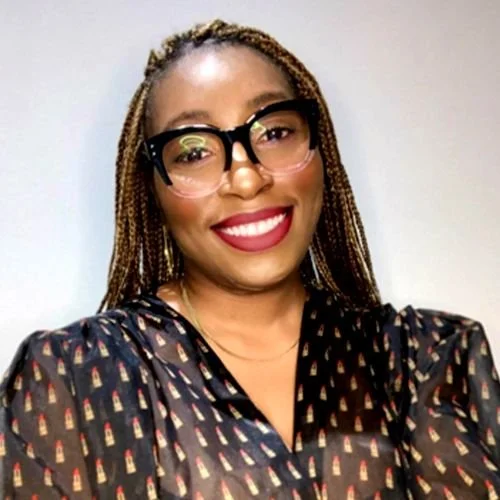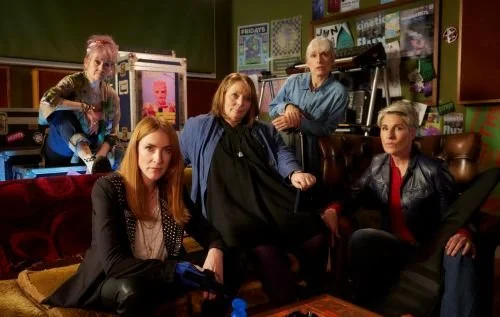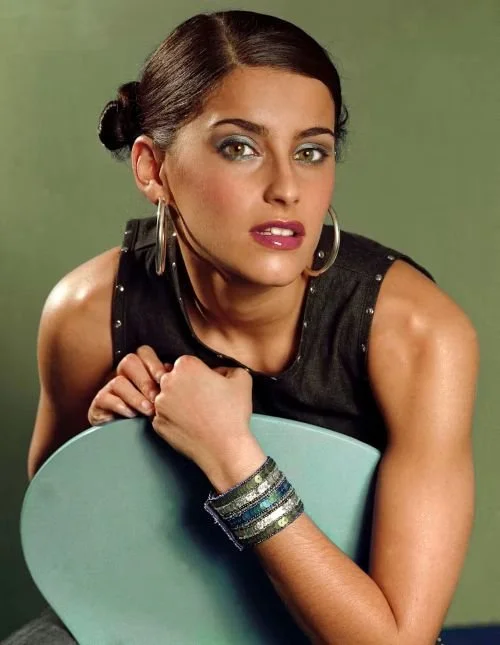FEATURE:
Spotlight
Upchuck
__________
THIS is another classic example…
of a great band having a terrible name. I have highlighted a few recently, including Turnstile. However, I will focus on Upchuck and the brilliant music, rather than dwell on their name. They have released one of this year’s most remarkable albums with I’m Nice Now. I will end with a review of that album. I want to start out to getting to a few interviews with the band. Despite the fact they have been around since 2018, they are not a well-known name in the U.K. That said, they have signed to Domino and are releasing their first album through the British label. The five-piece formed in Atlanta out of the city's skateboarding and D.I.Y. scene. The group consists of vocalist Kaila ‘KT’ Thompson, guitarists Michael ‘Mikey’ Durham, Alex ‘Hoff’ Hoffman, bassist Armando Arrieta, and drummer Chris Salado. I am quite fresh to Upchuck, but there are a few radio stations here that play them. They are currently touring in the U.K., which I hope means that their music will get more exposure and discussion here. Let’s get to some interviews. CRACK featured the band in September. Among the tour dates they had lined up for the U.K. was Blackpool. A band that seem out of place there, this was an interesting discussion point. However, the band’s intensely energetic, raw, and aggressive performances are resonating with people around the world. They are a band that people want and need to hear. Especially at such divided and horrible times like this:
“Upchuck bonded over their mutual love of skate culture and working the same part-time jobs before starting the band in 2018, with Thompson and Hoff both working at Tabernacle – a downtown Atlanta concert hall she jokingly describes as “for real artists”. Since tearing through Atlanta’s hardcore scene, they’ve shared stages with everyone from UK anarcho-punks Subhumans to garage-punk heavyweights Amyl and the Sniffers and Ty Segall.
The band have since racked up a catalogue of crazy tour stories in addition to the trolley incident, and Salado is happy to add to their lore, recalling a memorable exchange with Amy Taylor. “I was bitten at a gig and she said, ‘Dude. Please, go get a tetanus shot,’” Salado laughs, without confirming if he actually did. Disarmingly lovable, Salado quickly identifies himself as the one who keeps the group from taking itself too seriously. When asked who’s most likely to get arrested on tour, Thompson giggles and says: “Oh, definitely one of us,” nodding towards Salado and herself. As the two trade theories about what they’d be locked up for, the rest of the band sprawl out with greasy rider pizza, occasionally listening in and squeezing past to use the bathroom in the cramped green room.
Upchuck found a devoted cult following with their first two albums, Sense Yourself and 2023’s Bite the Hand That Feeds, even catching the attention of no-fucks-given rock royalty Iggy Pop and Henry Rollins on their radio shows. Now, the five-piece return with I’m Nice Now, their debut release with Domino. Pushing into new territory while keeping the raw urgency that propelled their earlier work, the result is nastier, filthier and, at times, unexpectedly groovy.
PHOTO CREDIT: Lilah Culliford
Upchuck’s politics are something they refuse to dilute or compromise, even as their audience grows. Drawing on Thompson’s lived experience as a Black woman and Salado’s as a Latin American, they use their time on stage, between crushing guitar onslaughts, to condemn the systems of oppression. This need to raise awareness was thrown into sharp relief after an incident that took place shortly after shooting the video for Plastic in their home city. In the video, Salado cruises through the streets in a lowrider like an already-made-it rock star, screaming headfirst into the camera. But a day after they wrapped, the scene quickly changed. “ICE pulled up in Sandy Springs, where the day labourers wait for work,” Salado says, his voice dropping heavily. “They took like ten people. No warrants, no proof. Just because they spoke Spanish or looked Hispanic. Some of them were even US citizens. This is what is happening.”
Unsurprisingly, much of I’m Nice Now grapples with Upchuck’s frustration over Trump’s second term and the fractured, volatile climate that has settled across America. But also, the record allows a space for Thompson to be vulnerable. She turns the lens inwards on Forgotten Token, softly describing her place in the world as a woman of colour. “The song is about being Black, and how people value your worth. Being Black can dictate how people perceive you or how they understand your talents”.
In this interview with Loud Women, Upchuck revealed how U.K. audiences are even rowdier than U.S. ones. Whilst American audiences I feel will always be louder and more exaggerated, it seems like we channel something else. A certain sense of chaos that you do not get in the U.S. No wonder that Upchuck are touring and loving it here. Let’s hope they come back to the U.K. next year and play another run of dates:
“I’ve heard you say previously that the Atlanta’s DIY scene is kind of a bit of a melting pot of punk bands and rappers and indie kids all colliding. Do you think that kind of cross pollination is part of the reason why Upchuck sounds the way it does?
Oh, for sure. I think, yeah, that’s the epitome of why we were even able to meet each other.
How did you come together then?
So, Mikey [guitarist Michael Durham] and Chris [drummer Chris Salado] were the first ones to start it. They, like, work together, in something like construction, okay? And I think Hoff [guitarist Alex Hoffman] ended up going with them and the bassist [Ausar Ward] as well. And I was working with the bassist, and he was like, ‘hey, I’m in this band, and we’re looking for a singer, like, if you want to, like, come check it out and try it out!’ And so I went over to Mikey’s, and I just seen, like, these men sitting on the couch, and they’re, like, writing lyrics. And I’m like, ‘Whoa, what?!’ Didn’t know it was going to be like this! But kind of once I recorded my part, I think, like, it all just kind of clicked for everyone. And we were like, man, okay, I think we should take this seriously.
So the album! I thought there’s punk and also a kind of a 90s grungy sound to the album. Were you deliberately drawing from different influences?
We were speaking to another interviewer the other day, and we were asked questions about, like, our writing process, and more and more I was like, ‘Wait, we’re kind of mad chaotic!’ Because there really is, like, no thought process behind it. It’s kind of just like a practice session, and it just gets created and made. We all just come together and sync up on that right there. But I think whatever is going on, like, instrumentation wise, when it comes to the to the boys, because I just play whatever they write. But when it comes to my writing, I’m just writing about whatever is literally happening in real time, or what I’ve dealt with in that process of writing. You could see the different levels of growth within that process, yeah.
And, wow, ‘Tired’ as the as the opener – it’s quite a ferocious way to open an album!
I think it’s, it has to do with, like, even the whole ‘I’m nice now’ concept. It’s upsetting. I’m kind of getting over yelling the same shit over and over again, preaching the same lesson, shit not changing, and watching real time shit get worse. The way that they have things set up over here in the States is just back-to-back-to-back bullshit, to break you down, and keep you weak, keep you defeated. But, at the end of the day, I’m tired of these tactics. I’m tired of these games. I’m tired of this ongoing and forever. It seems like the troubles never end”.
Prior to getting to Kerrang! and their review of I’m Nice Now, there is an interview with Femme Metal Magazine that I found interesting and had some good exchanges. Kaila ‘KT’ Thompson was questioned. I think there is a lot of love from a lot of the press. With every tour date and release comes this real sense that Upchuck are going to be massive. You can tell they are going to be remembered and talked about decades from now! So clear is that potential, you really need to follow Upchuck:
“The new album of Upchuck – I’m Nice Now
I know that I’m Nice Now is to be released via Domino Records on October 3rd. I wanted to ask you a little bit about the album’s general production and conception—when you started to collect the first ideas for it.
Actually, I would say it’s about a level of preservation. There’s so much shit being thrown at us constantly. I feel like there isn’t a day when something is going to shit, and that’s meant to break us down and make us feel defeated. I think that’s why the title is important; I’m trying to preserve myself to continue to deal with this day-to-day shit.
Upchuck debuts with Domino Records
“I’m Nice Now” also marks your debut with Domino Records. I wanted to ask how Upchuck came in contact with them and how the new collaboration adventure is treating you so far.
Our manager, Cyrus, was the main person behind this. We were with him on his old record label, but he had worked for Domino Publishing. We were talking about how sick it would be to be on Domino Records’s roster.
He did it, and Lawrence came to see our worst show. The sound man came up to us right before we went on, and the show sounded like shit. It’s funny, but they gave us a chance and saw us in Florida. It’s been sick; everyone comes to our shows and helps us out with logistics and everything. I feel like that’s a crazy weight lifted. I know it’s new for us, but I don’t feel overwhelmed”.
I am finishing up with that review from Kerrang!. James Hingle provided his assessment of perhaps the most angered, direct and powerful album of the year. One from a band who have released three albums so far, but you feel like their best is still ahead. Getting stronger with every album. The more they perform, the more they hone their skills and strengthen as a force. The Atlanta band can look back proudly at everything they have achieved this year:
“Atlanta punks Upchuck don’t just play songs: they spit venom, grind teeth and slam their fists against the rotting walls of America. On their third album, I’m Nice Now, the band sound like they’ve swallowed every injustice and vomited it back as pure punk fury. They take on the subjects of racism, sexism, classism and the whole ugly scaffolding of modern-day oppression and use their anger to add more fuel to their already fired-up punk sensibilities.
Opener Tired is an unflinching rallying cry. It’s the exhaustion of existing in a society built to grind you down, flipped into a giant middle finger at the powers that have constructed the foundations we’re expected to adhere to. Vocalist Kaila ‘KT’ Thompson doesn’t just carry rage in her voice, she embodies it with her sharp, ragged, human tones. And when drummer/vocalist Chris Salado jumps to the mic for Homenaje and Un Momento, singing in Spanish, it feels like a cultural reclamation, showing punk’s snarling edge to use their music for a greater good. These tracks are anthemic, if doused in a distorted barrage of punk aggression.
It’s Forgotten Token that cuts deepest. Written in the aftermath of KT’s sister’s death, it’s a gut-punch meditation on grief, commodification, and how people are devalued both in life and in death. Amid the band’s explosive noise, it feels like the record’s bleeding heart.
Ty Segall’s production keeps everything raw, live-to-tape and bristling with danger. Slow Down drips with 1970s Stooges grime, dragging you through sleaze and smoke, before closer Nowhere detonates in one last storm of serrated guitars, which acts as a final, furious fuck-you aimed squarely at a crooked system.
This is punk as it was always meant to be: loud, ugly, righteous and alive. I’m Nice Now isn’t just an album, it’s a survival tactic, a soundtrack to resistance in a country still burning”.
Go and show love and support for Upchuck. Currently performing in the U.K., they head to Europe from 11th November and have a date in Australia and one in New Zealand next year. It must be exhausting being on the road and delivering such incendiary sets. However, the energy they get from the crowds must give them that push! With all they have done this year, they have deserved a rest, and I hope Upchuck get to wrap up the year at home. For anyone who has not discovered the brilliance of Upchuck, go and listen to the five-piece…
AS soon as you can.
____________
Follow Upchuck
































































